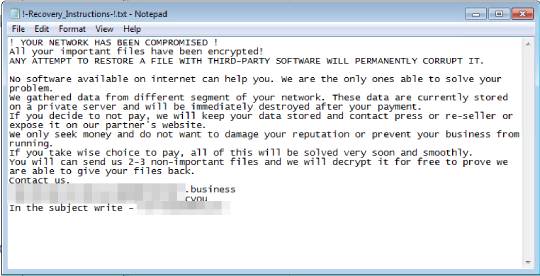Ransom.Win64.KEVERSEN.A
Ransom:Win32/Filecoder.AA!MTB (MICROSOFT)
Windows


Threat Type: Ransomware
Destructiveness: No
Encrypted: No
In the wild: Yes
OVERVIEW
Downloaded from the Internet, Dropped by other malware
This Ransomware arrives on a system as a file dropped by other malware or as a file downloaded unknowingly by users when visiting malicious sites.
It drops files as ransom note. It avoids encrypting files with the following file extensions.
TECHNICAL DETAILS
600,064 bytes
EXE
No
20 Apr 2022
Terminates processes, Steals information, Connects to URLs/IPs, Drops files
Arrival Details
This Ransomware arrives on a system as a file dropped by other malware or as a file downloaded unknowingly by users when visiting malicious sites.
Installation
This Ransomware adds the following processes:
- %System%\cmd.exe /c timeout 1 && del {Malware File Path)\{Malware File Name} >> NUL → deletes itself
- vssadmin.exe delete shadows /all /quiet → deletes shadow copies
(Note: %System% is the Windows system folder, where it usually is C:\Windows\System32 on all Windows operating system versions.)
Process Termination
This Ransomware terminates the following services if found on the affected system:
- vmickvpexchange
- vmicguestinterface
- vmicshutdown
- vmicheartbeat
- vmicrdv
- storflt
- vmictimesync
- vmicvss
- MSSQLFDLauncher
- MSSQLSERVER
- SQLSERVERAGENT
- SQLBrowser
- SQLTELEMETRY
- MsDtsServer130
- SSISTELEMETRY130
- SQLWriter
- MSSQL
- SQLAgent
- MSSQLServerADHelper100
- MSSQLServerOLAPService
- MsDtsServer100
- ReportServer
- TMBMServer
- postgresql-x64-9.4
- UniFi
- vmms
- sql-x64-9.4\r\nUniFi\r\nvmms
It terminates the following processes if found running in the affected system's memory:
- sqlserv.exe
- oracle.exe
- ntdbsmgr.exe
- sqlservr.exe
- sqlwriter.exe
- MsDtsSrvr.exe
- msmdsrv.exe
- ReportingServecesService.exe
- fdhost.exe
- fdlauncher.exe
- cher.exe
Information Theft
This Ransomware gathers the following data:
- Computer Name
- Domain Name
- Total RAM
- Number of CPUs
- Number of Disks
- Number of Encrypted Files
Other Details
This Ransomware does the following:
- It deletes itself after encryption using the following command:
- %System%\cmd.exe /c timeout 1 && del {Malware File Path)\{Malware File Name} >> NUL
- It downloads and executes Tor browser from the following URL:
- https://dist.{BLOCKED}ject.org/torbrowser/8.5.3/tor-win32-0.3.5.8.zip
Ransomware Routine
This Ransomware avoids encrypting files with the following strings in their file path:
- C:\Windows
- C:\Program files
- C:\Program files (x86)
- C:\System Volume Information
- C:\$Recycle.Bin
- C:\ProgramData
- Data
- C:\Program Files (x86)\Microsoft SQL Server
- C:\Program Files\Microsoft SQL Server
- C:\Program Files(x86)\Intuit
- C:\Program Files(x86)\MYOB
It appends the following extension to the file name of the encrypted files:
- .SunnyDay
It drops the following file(s) as ransom note:
- {Encrypted Folder}\!-Recovery_Instructions-!.txt

It avoids encrypting files with the following file extensions:
- .sql
- .mdf
- .txt
- .dbf
- .ckp
- .dacpac
- .db3
- .dtxs
- .mdt
- .sdf
- .MDF
- .DBF
- .DB
- .db
- .ndf
- .NDF
- .Mdf
SOLUTION
9.800
17.568.04
16 May 2022
17.569.00
17 May 2022
Step 1
Trend Micro Predictive Machine Learning detects and blocks malware at the first sign of its existence, before it executes on your system. When enabled, your Trend Micro product detects this malware under the following machine learning name:
- TROJ.Win32.TRX.XXPE50FFF056
Step 2
Before doing any scans, Windows 7, Windows 8, Windows 8.1, and Windows 10 users must disable System Restore to allow full scanning of their computers.
Step 3
Note that not all files, folders, and registry keys and entries are installed on your computer during this malware's/spyware's/grayware's execution. This may be due to incomplete installation or other operating system conditions. If you do not find the same files/folders/registry information, please proceed to the next step.
Step 4
Search and delete these files
- {Encrypted Folder}\!-Recovery_Instructions-!.txt
Step 5
Scan your computer with your Trend Micro product to delete files detected as Ransom.Win64.KEVERSEN.A. If the detected files have already been cleaned, deleted, or quarantined by your Trend Micro product, no further step is required. You may opt to simply delete the quarantined files. Please check the following Trend Micro Support pages for more information:
Step 6
Restore encrypted files from backup.
Did this description help? Tell us how we did.


